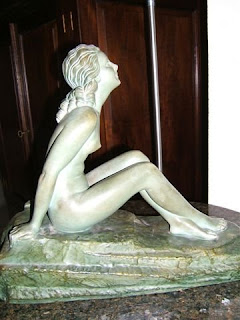The Henk Feijen Collection
 Anker Hoffman (1904-1985)
Anker Hoffman (1904-1985)The Dutch collector,
Henk Feijen,
has kindly sent me pictures
of the 20th C. sculpture
in his collection.

Back in earlier days of the Chicago Art Institute,
the collection was sometimes displayed by collector
rather than by date, period, or style.
The historicizing philosophy of modern scholarship
terminated that trend ---
but I think that's still a good idea,
because with an uncountable (and ever growing)
number of art works from which to choose,
the role of the collector
is nearly as important as that of the artist
in creating visual culture.
And I would say that the choices made
by the amateur collector are
far more important than those made
by the professional museum curator
because collectors have to live
with their choices every day.
So without further commentary,
here's the Feijen collection
(or, at least, my favorite parts of it)
One thing that I've been noticing lately
is how specific styles of figure sculpture
are to each nationality --
even in this modern era
where the curriculum of schools
and the canon of famous artists
is pretty the same
from one country to another.
There are distinctly Spanish, Italian, French,
American, Russian, Japanese, Belgian etc
ways of aestheticizing the human body,
and the Feijen collection seems to be
distinctly northern European.
 Valentin "Una"
Valentin "Una" Valentin
Valentin Vittorio Guttner (1869-1937)
Vittorio Guttner (1869-1937) Willhelm Andreas (b.1882)
Willhelm Andreas (b.1882) Pierre Le Faguays (1892-1962)
Pierre Le Faguays (1892-1962) Pierre Le Faguays
Pierre Le Faguays Ferdinand Preiss (1882-1943)
Ferdinand Preiss (1882-1943) Richard Gaston Dufour
Richard Gaston Dufour Spiro Schwatenberg (1898-1922)
Spiro Schwatenberg (1898-1922) Jan Toorop (1858-1928)
Jan Toorop (1858-1928) Limousin foundry
Limousin foundry Lucien Alliot (1877-1956)
Lucien Alliot (1877-1956) M. Saiy, 1920
M. Saiy, 1920 Paul Ducuing (1868-1949)
Paul Ducuing (1868-1949) Helmuth Schievelkamp, b. 1849
Helmuth Schievelkamp, b. 1849 Henry Calot
Henry Calot J.Dommisse (1878-1955)
J.Dommisse (1878-1955) Jacques-Auguste Fauginet
Jacques-Auguste Fauginet Jan Antheunis (1896-1973)
Jan Antheunis (1896-1973) Franz Bergman Foundry (Vienna)
Franz Bergman Foundry (Vienna) Friedrich Goldscheider
Friedrich Goldscheider Georges Petit (1879-1958)
Georges Petit (1879-1958) Ghanu Gantcheff (Bulgaria)
Ghanu Gantcheff (Bulgaria) Harry Van den Thillart (b. 1915)
Harry Van den Thillart (b. 1915) Chiparus (1886-1947)
Chiparus (1886-1947) Edouard Drouot (1859-1945)
Edouard Drouot (1859-1945) Edouard Drouot
Edouard Drouot Emil Cauer (1867-1946)
Emil Cauer (1867-1946) Emil Cauer
Emil Cauer+Drouot+1859-1945.JPG) Edouard Drouot
Edouard Drouot Alfredo Pina (1883-1966)
Alfredo Pina (1883-1966) Anders Jensen Bundgaard (1964-1937)
Anders Jensen Bundgaard (1964-1937) Vincent Becquerel (1893-1981)
Vincent Becquerel (1893-1981) Charles Samuel (1862-1938)
Charles Samuel (1862-1938)














